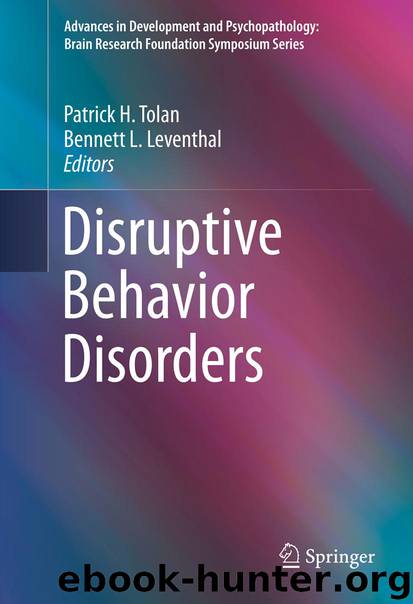Disruptive Behavior Disorders by Patrick H. Tolan & Bennett L. Leventhal

Author:Patrick H. Tolan & Bennett L. Leventhal
Language: eng
Format: epub
Publisher: Springer New York, New York, NY
The historical use of categorical diagnoses of disruptive behavior syndromes and disorders has been integral to clinical identification, treatment, and service utilization. The major nosological frameworks for classification have been the Diagnostic and Statistical Manual (DSM) (American Psychiatric Association, 2000) and International Classification of Diseases (World Health Organization, 2000). Increasingly, however, there is consensus that categorical approaches, which rely on an array of symptom criteria to classify an individual as having or not having a single disorder, may not fully capture clinical and developmental patterns of disruptive behaviors across the life cycle (Baillargeon, Zoccolillo, et al., 2007; Frick & White, 2008; Maughan, 2005; Rutter, 2003; Wakschlag et al., 2011). In contrast, multidimensional conceptualizations of psychopathology, which incorporate more than one domain or dimension of behavior and assess each domain/dimension along a continuum, offer many unique advantages to clinical characterization of disruptive behavior, including (1) improved characterization of heterogeneity, (2) provision of alternative strategies for understanding developmental course, (3) parsing the manner in which different components or dimensions of disruptive behavior may have varying associations with co-occurring symptoms, and (4) linkage of specific dimensions relevant to disruptive behavior to neurobiologic mechanisms as well as family and ecological contextual factors.
In this chapter, we propose a novel, developmentally based, multidimensional approach to disruptive behavior that can be applied across the life span to highlight the advantages of multidimensional versus dichotomous characterization. The specific dimensions identified within our multidimensional conceptualization of disruptive behaviors have strong support in the literature, but there is only preliminary work supporting the integrative approach that we present in this chapter. As a foundation, we first (a) highlight key findings in the history of categorical approaches to assessment of disruptive behavior disorders (DBDs), emphasizing research on subtypes that inform identification of salient dimensional components of disruptive behavior, (b) synthesize extant research and theory on dimensional approaches to disruptive behavior, and (c) review the advantages of adopting a multidimensional approach for deeper understanding of clinically significant disruptive behaviors. Following an elaboration of our multidimensional model of disruptive behavior, we conclude with a discussion of emerging areas of knowledge and critical next steps for scientific advancement. Although our approach is a life span framework, we focus particularly on early childhood to elucidate the framework—in part because of the particular complexities in the distinction between normative misbehavior and clinically concerning misbehavior in this period and in part because multidimensional inquiry about clinically significant disruptive behavior in early childhood has received more limited attention than inquiry about older children and adults.
Download
This site does not store any files on its server. We only index and link to content provided by other sites. Please contact the content providers to delete copyright contents if any and email us, we'll remove relevant links or contents immediately.
The Art of Coaching Workbook by Elena Aguilar(50739)
Trainspotting by Irvine Welsh(21420)
Twilight of the Idols With the Antichrist and Ecce Homo by Friedrich Nietzsche(18443)
Fangirl by Rainbow Rowell(9009)
Periodization Training for Sports by Tudor Bompa(8091)
Change Your Questions, Change Your Life by Marilee Adams(7552)
This Is How You Lose Her by Junot Diaz(6694)
Asking the Right Questions: A Guide to Critical Thinking by M. Neil Browne & Stuart M. Keeley(5569)
Grit by Angela Duckworth(5442)
Red Sparrow by Jason Matthews(5317)
Paper Towns by Green John(5018)
Room 212 by Kate Stewart(4956)
Ken Follett - World without end by Ken Follett(4588)
Housekeeping by Marilynne Robinson(4246)
The Sports Rules Book by Human Kinetics(4207)
Papillon (English) by Henri Charrière(4138)
Double Down (Diary of a Wimpy Kid Book 11) by Jeff Kinney(4130)
The Motorcycle Diaries by Ernesto Che Guevara(3925)
Exercise Technique Manual for Resistance Training by National Strength & Conditioning Association(3900)
